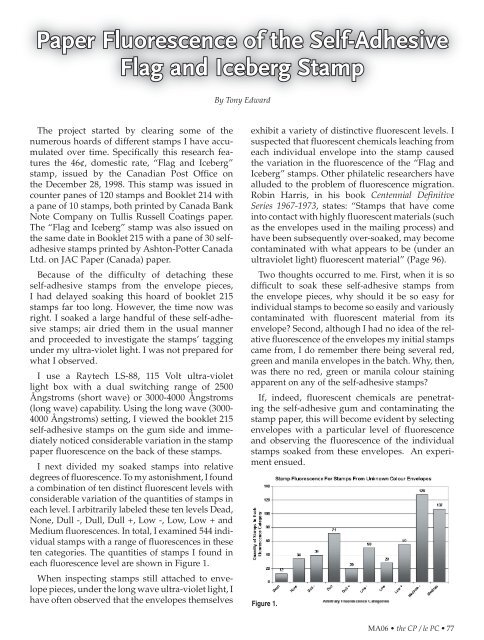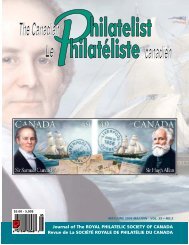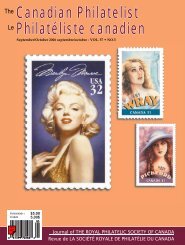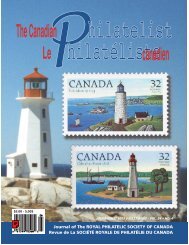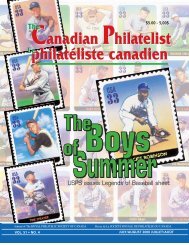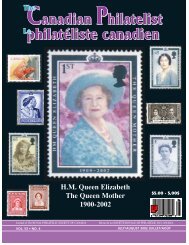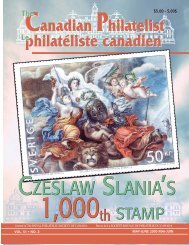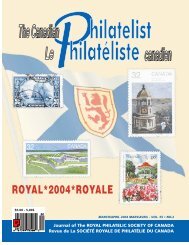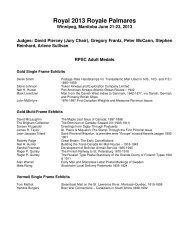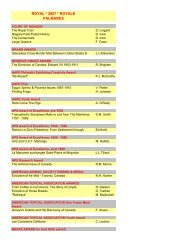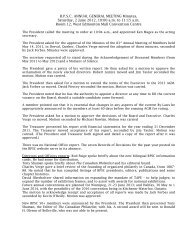Canadian Philatelist Philatéliste canadien - The Royal Philatelic ...
Canadian Philatelist Philatéliste canadien - The Royal Philatelic ...
Canadian Philatelist Philatéliste canadien - The Royal Philatelic ...
Create successful ePaper yourself
Turn your PDF publications into a flip-book with our unique Google optimized e-Paper software.
Paper Fluorescence of the Self-Adhesive<br />
Flag and Iceberg Stamp<br />
By Tony Edward<br />
<strong>The</strong> project started by clearing some of the<br />
numerous hoards of different stamps I have accumulated<br />
over time. Specifically this research features<br />
the 46¢, domestic rate, “Flag and Iceberg”<br />
stamp, issued by the <strong>Canadian</strong> Post Office on<br />
the December 28, 1998. This stamp was issued in<br />
counter panes of 120 stamps and Booklet 214 with<br />
a pane of 10 stamps, both printed by Canada Bank<br />
Note Company on Tullis Russell Coatings paper.<br />
<strong>The</strong> “Flag and Iceberg” stamp was also issued on<br />
the same date in Booklet 215 with a pane of 30 selfadhesive<br />
stamps printed by Ashton-Potter Canada<br />
Ltd. on JAC Paper (Canada) paper.<br />
Because of the difficulty of detaching these<br />
self-adhesive stamps from the envelope pieces,<br />
I had delayed soaking this hoard of booklet 215<br />
stamps far too long. However, the time now was<br />
right. I soaked a large handful of these self-adhesive<br />
stamps; air dried them in the usual manner<br />
and proceeded to investigate the stamps’ tagging<br />
under my ultra-violet light. I was not prepared for<br />
what I observed.<br />
I use a Raytech LS-88, 115 Volt ultra-violet<br />
light box with a dual switching range of 2500<br />
Ångstroms (short wave) or 3000-4000 Ångstroms<br />
(long wave) capability. Using the long wave (3000-<br />
4000 Ångstroms) setting, I viewed the booklet 215<br />
self-adhesive stamps on the gum side and immediately<br />
noticed considerable variation in the stamp<br />
paper fluorescence on the back of these stamps.<br />
I next divided my soaked stamps into relative<br />
degrees of fluorescence. To my astonishment, I found<br />
a combination of ten distinct fluorescent levels with<br />
considerable variation of the quantities of stamps in<br />
each level. I arbitrarily labeled these ten levels Dead,<br />
None, Dull -, Dull, Dull +, Low -, Low, Low + and<br />
Medium fluorescences. In total, I examined 544 individual<br />
stamps with a range of fluorescences in these<br />
ten categories. <strong>The</strong> quantities of stamps I found in<br />
each fluorescence level are shown in Figure 1.<br />
When inspecting stamps still attached to envelope<br />
pieces, under the long wave ultra-violet light, I<br />
have often observed that the envelopes themselves<br />
exhibit a variety of distinctive fluorescent levels. I<br />
suspected that fluorescent chemicals leaching from<br />
each individual envelope into the stamp caused<br />
the variation in the fluorescence of the “Flag and<br />
Iceberg” stamps. Other philatelic researchers have<br />
alluded to the problem of fluorescence migration.<br />
Robin Harris, in his book Centennial Definitive<br />
Series 1967-1973, states: “Stamps that have come<br />
into contact with highly fluorescent materials (such<br />
as the envelopes used in the mailing process) and<br />
have been subsequently over-soaked, may become<br />
contaminated with what appears to be (under an<br />
ultraviolet light) fluorescent material” (Page 96).<br />
Two thoughts occurred to me. First, when it is so<br />
difficult to soak these self-adhesive stamps from<br />
the envelope pieces, why should it be so easy for<br />
individual stamps to become so easily and variously<br />
contaminated with fluorescent material from its<br />
envelope? Second, although I had no idea of the relative<br />
fluorescence of the envelopes my initial stamps<br />
came from, I do remember there being several red,<br />
green and manila envelopes in the batch. Why, then,<br />
was there no red, green or manila colour staining<br />
apparent on any of the self-adhesive stamps?<br />
If, indeed, fluorescent chemicals are penetrating<br />
the self-adhesive gum and contaminating the<br />
stamp paper, this will become evident by selecting<br />
envelopes with a particular level of fluorescence<br />
and observing the fluorescence of the individual<br />
stamps soaked from these envelopes. An experiment<br />
ensued.<br />
Figure 1.<br />
MA06 • the CP / le PC • 77


